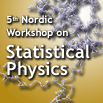Speaker
Dr
Astrid de Wijn
(SU Fysikum/Kemisk Fysik)
Description
Diffusion can be strongly affected by the appearance of
ballistic flights (long jumps) as well as long-lived
sticking trajectories (long sticks). Using statistical
inference techniques, we investigate the appearance of long
jumps and sticks in molecular-dynamics simulations of
diffusion in a prototype system, a benzene molecule on a
graphite substrate. These techniques are usually reserved
for prediction of large rare events, such as earth quakes
and strong wind gusts. We find that specific fluctuations
in certain, but not all, internal degrees of freedom of the
molecule can be linked to the occurrence of either long
jumps or sticks. Furthermore, we show that by changing the
prevalence of these predictors with an outside influence,
the diffusion of the molecule can be controlled. The
approach presented is very generic, and can be applied to
larger and more complex molecules. Additionally, the
predictor variables can be chosen in a general way so as to
be accessible in experiments, making the method feasible for
control of diffusion in applications. Our results also
demonstrate that data-mining techniques can be used to
investigate the phase-space structure of high-dimensional
nonlinear dynamical systems.

